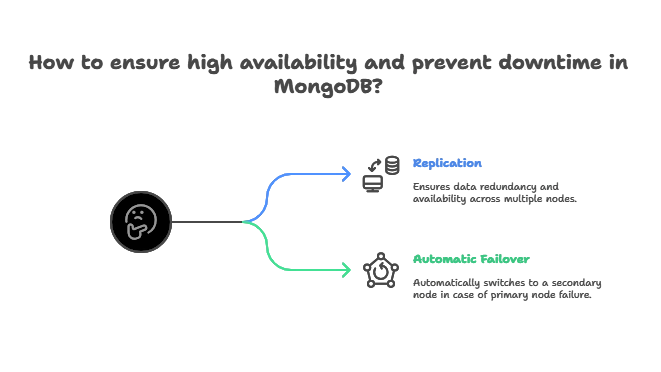Handling Failover and Recovery Scenarios in MongoDB
Handling failover and recovery in MongoDB ensures that your application can withstand unexpected issues, from server failures to network disruptions, and continue to function seamlessly. This chapter covers key strategies for implementing reliable failover, the principles of data recovery, and how MongoDB’s architecture supports high availability and resilience.
Introduction to Failover and Recovery in MongoDB
Failover and recovery mechanisms are designed to prevent downtime and data loss, making MongoDB resilient against hardware failures, crashes, and network issues. MongoDB’s high availability strategy mainly relies on replication and automatic failover, ensuring continuous service.

High Availability and Replication Concepts
High availability (HA) is the ability of a system to remain accessible despite failures. Replication in MongoDB means duplicating data across multiple servers, ensuring data redundancy and enabling seamless failover.
MongoDB uses replica sets as its core replication model:
- Replica Set: A group of MongoDB instances that maintain the same data.
- Primary Node: Handles read/write operations.
- Secondary Nodes: Replicate data from the primary and provide read availability if configured.
Understanding MongoDB Replica Sets
Replica sets are a foundational feature for MongoDB’s failover and recovery:
- Primary Node: Accepts all writes and synchronizes with secondary nodes.
- Secondary Nodes: Use oplogs (operation logs) to stay updated with the primary, allowing for data redundancy.
Replica sets support both automatic failover and recovery. If the primary node fails, an automatic election occurs among the secondaries to select a new primary.
Automatic Failover Mechanism in MongoDB
MongoDB’s failover is automatic within a replica set. When the primary node becomes unavailable:
- Detection: Secondary nodes detect the primary’s failure based on heartbeat intervals.
- Election: An election process among secondaries determines the new primary.
- Recovery: Applications reconnect to the new primary for ongoing operations.
This automatic failover minimizes downtime and keeps applications operational.
Configuring a Replica Set for Failover
Setting up a replica set is straightforward but requires proper configuration. We’ll cover setting up a three-node replica set as an example.
- Initialize the Replica Set: Configure MongoDB nodes with unique identifiers.
- Add Members to the Set: Define each node’s role (primary, secondary, or arbiter).
- Test Configuration: Ensure proper synchronization and availability.
Example: Configuring a Replica Set in MongoDB
- Start MongoDB instances (ensure each has a unique data directory and port).
- Connect to the primary node and initialize the replica set:
rs.initiate({
_id: "myReplicaSet",
members: [
{ _id: 0, host: "localhost:27017" },
{ _id: 1, host: "localhost:27018" },
{ _id: 2, host: "localhost:27019" }
]
});
3.Check the status with rs.status() to confirm each node’s role.
Handling Failover Events
When a failover occurs:
- Secondary Election: MongoDB initiates an election to choose a new primary.
- Client Reconnection: Applications using MongoDB drivers automatically reconnect to the new primary.
- Minimal Downtime: Failover typically completes within seconds, minimizing service interruptions.
Example Scenario: If the primary at localhost:27017 fails, the secondary with the next highest priority takes over. Applications should handle potential reconnections by configuring retries.
Disaster Recovery Strategy in MongoDB
Disaster recovery prepares for worst-case scenarios, such as data corruption or data center loss. MongoDB’s disaster recovery strategy includes:
- Periodic Backups: Regularly schedule backups to a secure, offsite location.
- Geographically Distributed Replica Sets: Place replica members in different data centers for enhanced resilience.
Data Backup and Restoration Techniques
MongoDB offers two primary backup methods:
- Mongodump and Mongorestore: Suitable for small- to medium-sized data sets.
- File System Snapshots: Efficient for large databases and provides a point-in-time snapshot.
Using mongodump and mongorestore
Backup:
mongodump --uri="mongodb://localhost:27017" --out /backup/
Restore:
mongorestore --uri="mongodb://localhost:27017" /backup/
Snapshots, on the other hand, are more efficient for large, production-grade databases and are managed by storage systems.
Testing Failover and Recovery Scenarios
Testing failover helps ensure the system can handle unexpected failures without data loss or extended downtime.
- Primary Node Failure: Shut down the primary and observe the election of a new primary.
- Network Partition: Simulate a network partition by isolating a node.
- Data Consistency Verification: Confirm that secondary nodes are up-to-date after failover.
Example Test: Simulate Primary Failure
Shut down the primary:
sudo service mongod stop
2. Verify that a secondary has taken over by running rs.status() on a secondary.
Best Practices for Failover and Recovery Management
- Monitor Replica Set Health: Regularly check replica set status using
rs.status()and alert on issues. - Test Failover Regularly: Schedule failover drills to ensure readiness.
- Use Priority Configuration for Failover Control: Configure secondary nodes with different priorities to control failover order.
- Set Up Alerts for Failover Events: Use MongoDB monitoring tools to alert on primary node changes.
- Document Failover Procedures: Clearly document your organization’s failover response plan.
MongoDB’s automatic failover and robust disaster recovery capabilities provide high availability for mission-critical applications. By using replica sets, regular backups, and carefully managed failover configurations, MongoDB can maintain data integrity and availability under various failure scenarios, ensuring resilient database operations. Happy coding !❤️
